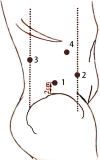Management of renal tumors during pregnancy: case reports
- PMID: 33836679
- PMCID: PMC8035726
- DOI: 10.1186/s12882-021-02318-w
Management of renal tumors during pregnancy: case reports
Abstract
Background: Renal tumors during pregnancy are rare and the treatment requires evaluation of both the patient and the fetus. No consensus or guidelines has been proposed or verified in this field. We successfully managed three renal tumor cases during pregnancy and reviewed the relative literature.
Case presentation: In the first renal cell carcinoma case diagnosed in the 21st week of pregnancy, laparoscopic retroperitoneoscopic partial nephrectomy was performed in the 26th week of pregnancy. In the second renal cell carcinoma case diagnosed in the 3rd week of pregnancy, laparoscopic retroperitoneoscopic radical nephrectomy was carried out after the abortion. In the third angiomyolipoma case who was diagnosed before pregnancy but received no treatment, we performed laparoscopic retroperitoneoscopic partial nephrectomy during the 17th week of pregnancy due to the rapid enlargement of the tumor.
Conclusion: Although no consensus or guidelines for the management of renal tumors in pregnant patients has been proposed or verified, the general rules of kidney tumor management in non-pregnant patients and the guidelines for surgery in pregnancy could be referred to. Renal tumors found in pregnant patients require an individualized treatment regimen involving surgical timing, routes, techniques, and excision ranges, which should be decided by both the patients and the surgical teams.
Keywords: Laparoscopy; Nephrectomy; Pregnancy; Renal angiomyolipoma; Renal cell carcinoma; Renal tumors.
Conflict of interest statement
The authors declare that they have no competing interests.
Figures
Similar articles
-
A 27-Year-Old Primigravida with a Right Renal Cell Carcinoma Removed at 30 Weeks of Gestation by Robot-Assisted Retroperitoneoscopic Partial Nephrectomy.Am J Case Rep. 2021 Apr 18;22:e927164. doi: 10.12659/AJCR.927164. Am J Case Rep. 2021. PMID: 33866322 Free PMC article.
-
Posterior retroperitoneoscopic partial nephrectomy using microwave tissue coagulator for small renal tumors.J Endourol. 2002 Aug;16(6):367-71. doi: 10.1089/089277902760261400. J Endourol. 2002. PMID: 12227911
-
Retroperitoneal laparoscopic radical nephrectomy for renal cell carcinoma during pregnancy.Urol Int. 2013;90(4):487-9. doi: 10.1159/000346334. Epub 2013 Feb 9. Urol Int. 2013. PMID: 23407021 Review.
-
Laparoscopic nephrectomy for renal-cell carcinoma during pregnancy.J Endourol. 2004 Nov;18(9):871-4. doi: 10.1089/end.2004.18.871. J Endourol. 2004. PMID: 15659923 Review.
-
Laparoscopic-assisted partial nephrectomy combined with open procedure for posteromedial renal tumors.Urology. 2010 Dec;76(6):1414-8. doi: 10.1016/j.urology.2010.02.059. Epub 2010 May 23. Urology. 2010. PMID: 20546872
Cited by
-
Eosinophilic Variant of Chromophobe Renal Cell Carcinoma During Pregnancy: A Multidisciplinary Approach and Successful Management in a Tertiary Hospital in Mexico.Cureus. 2023 Sep 9;15(9):e44955. doi: 10.7759/cureus.44955. eCollection 2023 Sep. Cureus. 2023. PMID: 37701169 Free PMC article.
References
Publication types
MeSH terms
LinkOut - more resources
Full Text Sources
Other Literature Sources
Medical


